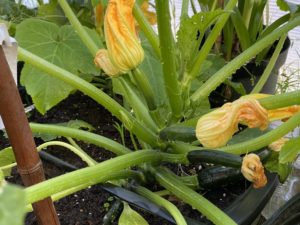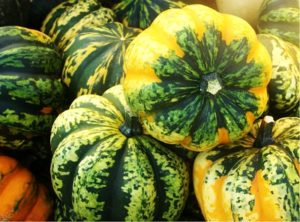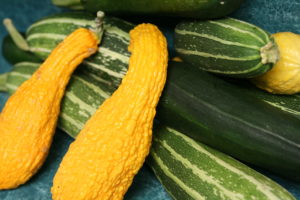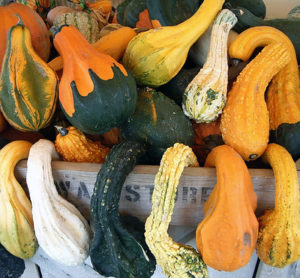Squash was first grown and cultivated throughout North and South America, thousands of years before any contact with Europe. They are part of the “Three Sisters” style of companion planting, with corn, squash, and beans planted together. This is one of the best ways to grow these plants sustainably, year after year. It’s not always practical for smaller gardens, and squash can be grown perfectly well on its own.

Squash Varieties
There are two main types of squash that are important to distinguish: Summer squash and Winter squash. Summer squash is mostly comprised of bush varieties., with a few exceptions that grow in long vines. Summer squash types include Zucchini, Pattypan squash, Yellow Straightneck squash, and Crookneck. Winter squash is mostly vining types, though there are a few bush and semi-bush types that take up a bit less space. A few of the more popular types of winter squash are Acorn squash, Delicata, Spaghetti squash, and of course, Butternut squash. The name “Winter Squash” comes from the fact that due to their hard shells they can be stored after harvest for a long time, all the way to winter. They are not cold tolerant while they’re growing! Pumpkins were cultivated from winter squash.

Summer squash has a mild flavor, buttery or nutty, and can be prepared by steaming and roasting, serving as part of a casserole, and in many other ways. Zucchini and other summer squashes are interchangeable in the kitchen and are great substitutes for each other in any recipe. Summer squashes are high in vitamin C (especially Zucchini), and are a good source of Vitamin B. The vitamin C content makes them good as an antioxidant. Winter squash is sweeter, with butternut squash being the sweetest. All are great for making pies and serving as a main course or a side dish, or even cut up raw for salads! Any winter squash is high in vitamin A and is a good potassium source.

Planting Information
- Squash: Cucurbita pepo, Cucurbita maxima, Cucurbita moschata
- Annual
- Full sun (6-8 hours minimum)
- Soil should be slightly acidic, pH between 5.8 and 6.8
- Well-drained, slightly sandy or loamy, fertile soil
- Garden planting: Space low hills, 48” apart, plant 4 seeds per hill, 1” deep.
Use a trellis if desired, or ensure to keep fruits off of bare dirt.
- Container planting: Bush varieties, one plant per 24” to 30” wide container. Ensure it drains well.
Provide a trellis if needed to save space and aerate the plant.
- Climate Zones: Winter squash 2-11, Summer squash 3-10
Winter squash is best from 50°F-90°F. Summer squash is best from 60-75°F.
- Time to maturity: Winter squash 80-120 days, Summer squash 60 days or so
How to Grow Squash
Vining Squash
Vining varieties of Winter squash should be planted in hills, 6-8 inch tall, with 4 seeds per hill. Thin the sprouts to two plants on each hill. The hills should be about four feet apart (48”). They can be seeded directly or started early indoors, in areas with colder climates and a shorter growing season. Plant the seeds or transplant the seedlings carefully about two weeks after the last frost. Keep well watered. If using a trellis to support the plant, keep the vines tied up as they grow. Be sure to support the fruit as it grows, to keep it from falling off the vine. They can be allowed to spread out on the ground, but they will take up some space. For vining squash, it’s important to keep the squashes off the bare ground to prevent rotting and allow the fruit to ripen correctly. Using wood chips or straw as mulch over the soil is good, and there are “squash cradles” (sold also as “melon cradles”) that are available and easy to use. You can even put a piece of cut cardboard under each squash as it matures.
Bush Squash
Bush types of Summer squash should also be planted in hills spaced 4 feet apart, with 4 seeds per hill, just like the vining types. They are bush-type plants – mostly. They still will spread out over a wide area and can be trained to grow on a trellis. If you don’t use a trellis, it is best to plant them along the edge of the garden. There are vining Summer squash varieties and bush or semi-bush Winter squash varieties, but the distances will work for both types. Keep watered very regularly. Summer squash does need more moderate temperatures than winter squash.

Growing Squash in Containers
For containers, it is best to use the bush type of squash, though if you have a large trellis, the vining types can be grown this way. Potted squashes grow very well but they do require a large pot. Container growing makes it easier to control pests and to keep the soil and plants warm, especially during early growth. Well-drained containers are needed, and you should water very regularly, more often than with garden-grown squash. Additional fertilization as they grow is also very helpful. This will help the plant grow strong without the extra soil and water resources from growing in the ground.
Squash Pests
Pests can be prevented by some companion plants. Aromatic herbs like dill, oregano, and parsley will attract ladybugs, to help control aphids. Flowers like nasturtiums planted somewhat nearby will attract aphids and flea beetles and keep them away from the squash. For other pests like cucumber beetles and squash beetles remove them by hand. For squash vine borers slice the vine open vertically and remove the bug. Organic Neem Oil spray can also be effective against these pests. Diseases include viruses like zucchini yellow mosaic (and cucumber mosaic), and other similar mosaic infections. These cause a scattered yellow color on the leaves. Bacterial wilt will cause the leaves to droop, turn yellow and die. Prevention is the best cure – keeping the plants weeded and controlling aphids and other pests, as well as planting disease-resistant varieties, is the best way to avoid this.

Harvesting Squash
Summer squash takes about 60 days to get to harvest size, which is usually 6-8 inches in length for zucchini and yellow squash, and 4-6 inches in diameter for pattypan squash. They should not get too big, as the skin will harden and they will become bitter. Start harvesting on the early side, more squashes will grow. Winter squash takes longer, and they should be harvested at 3-4 months when the color has fully turned, and the rind has hardened completely. This will usually be in September or October, before the first frost. Cut the stem with pruning shears or a knife a few inches above the top of the fruit. Butternut squash and yellow straightneck and crookneck squash should be cured for a week, allowing them to sit in the sun for about a week before storing them, this will improve the flavor. They can be stored in a cool dry space for at least a few months. Seeds can be harvested from any heirloom squash. For winter squash just save the seeds after you use the flesh. For summer squash, let a few fruits continue to grow until the skin hardens and the plant is fully mature. It won’t be the best for eating, but the seeds will be mature and can be removed for harvest. For both, ensure the seeds are washed and fully dried, and they can be saved for use the following year!
Get started with Hortisketch. Plan your garden today!


Contact Author
 Info@gardensavvy.com
Info@gardensavvy.com Recent Posts
- Smart Gardening: How Technology Is Revolutionizing Horticulture
- Understanding Gardening Zones: What You Need to Know
- The Right Tools For Your Gardening And Landscaping Needs
- Maximizing Your Harvest: Square Foot Gardening Chart for Beginners
- Holiday Garden Scents: Plants for Natural Aromatherapy in Your Home









